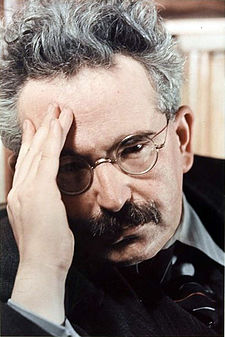Benjamin, writing about the Klee’s “Angelus Novus” painting, portrays the angel of history, as it were, caught by the wind of time and being carried away by the force that exceeds the angel’s capacity to resist it:
“The angel would like to stay, awaken the dead, and make whole what has been smashed. But a storm is blowing from Paradise; it has got caught in his wings with such violence that the angel can no longer close them. This storm irresistibly propels him into the future to which his back is turned, while the pile of debris before him grows skyward. This storm is what we call progress.” (Benjamin, 1968, 258)
The angel that we see in Klee’s painting is indeed disheveled.

In his curls one might even see something resembling of Benjamin himself.

What interests me here, however, is not an imaginary or real semblance of the work of art and the portrait of the thinker who muses upon it. Perhaps as much as it is possible to claim that the work of art is always to this or that degree a self-portrait of the author, the work of art appropriated for an analysis (especially this far-winged as Benjamin’s analysis is) is also reading in the work of art of something to which the work of art serves as merely a pretext, that is to say, a self-portrait of sorts as well.
The past, which is constantly re-evaluated, by everyone, and in particular by the state, with some moments summoned and some, erased, appears in the image of a bunch of debris, detritus, floating in the wind of history (of progress) in Benjamin’s vision. The past, moreover, does not “exist” but is summoned. Not only every summoning of the past is arbitrary, divergent, creative, and interpretive, but there is no way “it really was” either, contradictorily to, or, rather, additionally to Benjamin’s assessment “To articulate the past historically does not mean to recognize it “the way it really was” (Ranke)” (Benjamin, 1968, 255). History, written and re-written in the interest “of the ruling classes” (Marxist thesis), we see increasingly in the modern times, is but an agglomeration of myths. Public does sympathize with the victor, and will always be sympathetic of victors–however, from a metaphysical point of view, the true victor is the one who lost the fight, and in this case the sympathies are uncertain. However official propaganda would frame the events, there will always be a recalcitrant part of the society stubbornly empathizing with the “losers,” preparing the soil for the dragon’s teeth to grow into a new, tomorrow-victorious, army. (As an example might serve the Whites opposing the Reds in the Civil War in Russia. Despite the victory of the Red Army, the White cause was not entirely defeated, and although there is no point in history when it could win either, there were always sympathies during the Soviet times for the defeated, which is also connected perhaps with the Orthodox moral demanding mercy for the conquered.)
It is necessary to put “the pile of debris before” the angel–which are, despite that they are situated in front of his eyes, are the debris of the past, unequivocally, since he’s dragged by the wind into the future–in context with ruins Benjamin mentions in the “Exposé” of 1935 to The Arcades, the fragment that did not make it into the later, 1939 version of “Exposé”:
“Balzac was the first to speak of the ruins of the bourgeoisie. But it was Surrealism that first opened our eyes to them. The development of the forces of production shattered the wish symbols of the previous century, even before the monuments representing them has collapsed. With the destabilizing of the market economy, we begin to recognize the monumets of the bourgeoisie as ruins even before they have crumbled.” (Benjamin, 1999, 13).
To decode the Benjamin’s link onto Balzac, it is best to examine this piece by Balzac quoted in The Arcades Project under code C2a,8:
“The ruins of the Church and of the aristocracy, of feudalism, of the Middle Ages, are sublime–they fill the wide-eyed victors of today with admiration. But the ruins of the bourgeoisie will be an ignoble detritus of pasteboard, plaster, and coloring.”<Honoré de Balzac and other authors,> Le Diable á Paris (Paris, 1845), vol. 2, p. 18 (Balzac, “Ce qui disparait de Paris”). ▯ Collector ▯ [C2a,8] (Benjamin, 1999, 87).
Here, regardless of how often the bourgeoisie’s palaces are seen in ruins, only for them, it seems, to be built anew with no regard to the proverbial past, Benjamin talks about the anticipated ruins, the ruins that are to be, the ruins that we can see in the future before they are ruins: about the material debris and traces of that present which is about to turn into the past.
Balzac is even more visceral in his description of these ruins: “ignoble detritus of pasteboard, plaster, and coloring.” One might expect decay and putrefaction in these amorphous piles that are indeed perhaps are better called rabble than ruins, in comparison to the ruins retaining form referring to the previous socio-political formation, that of feodalism. Like aristocracy is the ruling class of feodalism, bourgeoisie is the ruling class of the formation known as capitalism in the Marxist taxonomies. In the Balzacian detritus it is not difficult to see the Benjaminian pile of debris carried away from the face of the angel of history, also carried away by the supreme force of progress. But what it tells us beyond what it tells about unfulfilled dreams of progress and failed expectations? When does the production of these debris ends? In the impossible, ideal moment when the past is finally restored just “as it all was”, the dead resurrected, the mankind redeemed, and the final judgement of history has been irreversibly pronounced?
References
Benjamin, Walter. The Arcades Project. The Belknap Press of Harvard University Press. 1999.
Benjamin, Walter. “Theses on the Philosophy of History.” Illuminations. Schoken Books, New York, 1968.



